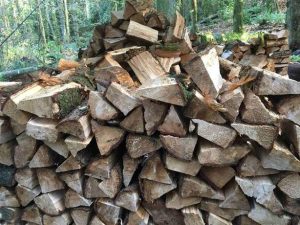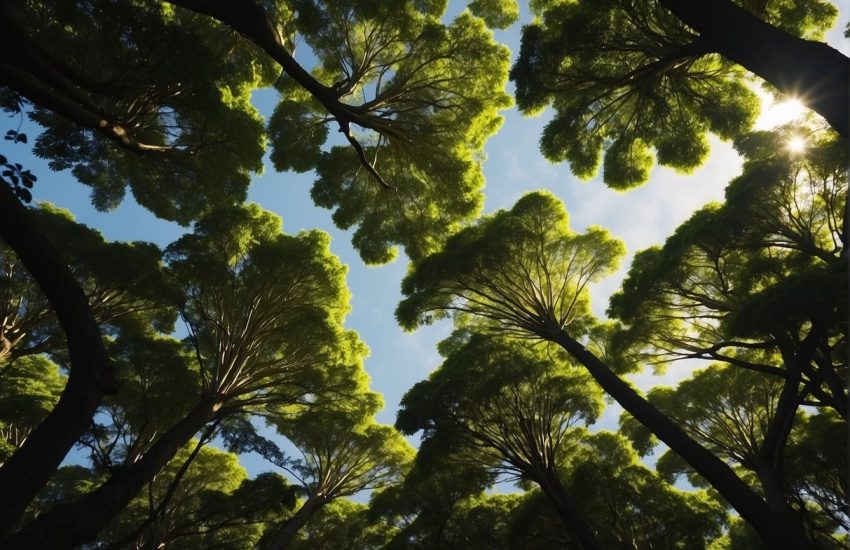Does Hemlock Make Good Firewood?
Hemlock is an excellent firewood, but it doesn’t have the best burn qualities. The wood will burn hot and fast, which can be good if you need to get something going quickly. However, it also burns quickly, so you’ll want to make sure you have enough fuel on hand before starting your fire. Read the whole of this guide before choosing to use hemlock for firewood.

How Hemlock Compares To Other Trees
Hemlock is a softwood, which means it’s much softer than hardwoods like oak or maple. Softwoods tend to be more flammable than hardwoods. They catch fire faster and burn hotter. But they also don’t last as long in the fireplace, so you’ll want to keep an eye on your fire as you’re burning hemlock.
Heat Output and Efficiency (BTUs)
Hemlock is a low-density wood. This means that it’s not very dense, so it doesn’t burn as hot or for as long as other hardwoods. Heavier woods like oak and maple have significantly more BTU (heat) output than hemlock, which means you’ll need to burn more to get the same heat from your fire.
In terms of efficiency and heat output, there are better woods to use than hemlock.
Reliable sources indicate that hemlock has a BTU of 19 million BTU per unit cord. This implies it can give out enough heat to keep your surroundings warm. It’s BTU is also relatively higher than some softwoods, making it excellent firewood for camping and indoor fireplace use.
How Long To Season Hemlock Firewood?
Hemlock firewood is often sold in bundles, so it’s essential to know how long to season hemlock wood before using it.
There are three ways you can store hemlock wood, all of which take a long time to season.
A pile of hemlock wood should be left outside for at least twelve months before you burn it. The best place for this type of storage would be on the ground or in a shaded area where water cannot pool in your pile. This will ensure that all moisture has been drawn out from within the logs and they have started drying out naturally.
The time required for this type of drying depends on the humidity levels and temperature where your pile sits during that period. However, one year is about average for most areas where hemlocks grow naturally.
If you don’t want to wait until outdoors conditions are warm enough for natural seasoning, then you can opt instead for storing your logs indoors. Remember that since heat rises from inside homes and buildings, they may dry faster than outdoors if kept there early enough. Consider placing some plastic under each layer to help prevent rot while keeping any mold spores away from those lower down on top layers.
How Hard is Hemlock To Split?
Hemlock is a softwood, so it’s not as hard as oak. The best way to split hemlock is with an axe or maul. You can also use wedges and sledgehammers, but these are much slower than using an axe or maul. When splitting with an axe or maul, stand the log on its end and aim for the side grain. If you aim for the end grain of your log, you will almost certainly fail because it is so dense that it won’t be able to split apart easily.
You should store your split logs somewhere dry, like under cover or in a shed, if they are not going to be used immediately, so they don’t rot away before you get around to burning them.
Is Hemlock Sap Messy?
So what is hemlock sap? It’s sap that comes out of the tree when it’s cut or injured. The sap contains resins that prevent insects from feeding on it and can also cause skin irritation if you come into contact with it. If you get some on your hands or clothing, wash immediately to avoid irritation.
Other Common Uses of Hemlock
Hemlock has many uses around the home, so it should be easy to find one near where you live or work if needed for firewood purposes. You can also order online without having to venture too far from home. It does well with kindling or kindling mixed with larger pieces for longer burning pieces. However, make sure plenty is available before deciding which type best suits your needs.
Hemlock is also used for furniture, flooring, and paneling. It is frequently used in fence posts and railings. Hemlock is also commonly utilized for paper pulp, plywood, and particle board as it has a shallow resin content.
The wood from hemlock trees makes excellent firewood because it burns cleanly with little smoke or odor, which makes it safe to use indoors or in enclosed areas without ventilation systems.
How To Store Hemlock Firewood
The best way to store hemlock firewood is by keeping it dry, away from moisture, sunlight, insects, and rodents. If you can keep your hemlock wood inside a shed or garage, that would be ideal for storing the wood, but if this is not an option, then setting up a simple lean-to structure should do just fine.
The key element of this structure is screening material such as mosquito netting or shade cloth which will help keep out insects and rodents but allow airflow through the shelter so that moisture does not accumulate on the wood’s surface.
What Does Hemlock Smell Like?
Hemlock is a coniferous tree that grows in the northern parts of North America. The wood has a distinctive smell when you cut it, but it’s not something you want to inhale unless you’re used to working with it.
It can be used for survival in fires and fireplaces, but it isn’t suited for indoor use due to its strong smell and tendency to cause respiratory problems in some people. If you’re looking for an alternative fuel source for cooking or heating your home, you might consider other softwoods that burn slowly with a gentle smell.
Types of Hemlock Tree Used For Firewood
Several different types of hemlock trees grow in North America. Each species has its own characteristics, including its native range, height, and appearance. Some species can also be used for firewood, while others are better suited as lumber or pulpwood.
Here’s an overview of all the different hemlocks you may encounter.
1. Eastern Hemlock
Eastern hemlock is a softwood tree that grows in the eastern half of the U.S. and Canada. It is an evergreen tree that grows to a height of up to 60 feet, with a trunk diameter of up to 2 feet. The bark is similar in appearance and texture to Eastern white pine.
Eastern hemlock has been used as a Christmas tree since it was introduced into North America by early settlers in 1749. However, it’s not as popular as other types of trees due to its relatively small size at maturity, usually less than 20 feet tall, and its poor needle retention once cut from its branches.
The wood is used to manufacture plywood, veneer, and paper pulp. Eastern hemlock is susceptible to many fungal diseases that can cause significant damage to trees. The most common disease affecting eastern hemlock is Hemlock Woolly Adelgid (HWA), which results in premature leaf loss among affected trees.
2. Western Hemlock
Western hemlock is a coniferous tree that grows up to 100 feet tall and is found in North America’s Pacific Northwest. The hemlock of the west is a member of the pine family, and it bears many similarities to its eastern counterpart, which includes white pine and red spruce.
While both species grow in similar climates (humid coastal areas or cold temperate rain forests), western hemlocks prefer drier sites than their eastern counterparts do. They also differ from eastern hemlocks in appearance. While all have needles on their branches, westerns have single needles rather than clusters; their cones appear smaller than eastern ones.
Western Hemlock’s bark is thin compared to other members of its genus. This makes it easier for insects like pine beetles to penetrate them during periods without rainfall. This is when sap levels are low enough to feed on wood tissue beneath layers of bark rather than just outer edges.
3. Mountain Hemlock
The mountain hemlock is a coniferous tree that grows in the mountains of western North America, including Alaska, British Columbia, Oregon, and Washington. It is the most common species of conifer in the Pacific Northwest.
Mountain hemlocks are fast-growing trees that can grow to be 60 feet tall but are typically shorter than that. These impressive trees have blue-green needles that turn yellow in autumn and brown when they drop off at the end of winter.
They also have cones that turn brown when they mature. The bark of mountain hemlock is gray and smooth and can be up to 4 inches thick.
The hemlock species most commonly used for firewood is the eastern hemlock. It is a widespread tree in the northeast of North America and can be found from Maine to Virginia and westward into Ontario and Quebec. The western hemlock is also used for firewood, but it’s not as common because it only grows in certain areas.
The mountain hemlock is another type of tree that grows in mountainous areas like Canada or New England, where other types of wood may not grow as well due to their soil quality being too acidic or rocky terrain.
Pros and Cons of Using Hemlock For Firewood
Pros
- Easy to ignite
- Smells great
- Lots of hot flame
Cons
- Burns quickly
- Not easy to split
Conclusion
Overall, hemlock is a great choice for your fireplace and makes excellent firewood. It burns hot and fast, so it’s perfect for those cold winter days when you need to get warm fast. Hemlock is also easy to store and won’t give off unpleasant smells like some other woods might do as they dry out over time. If you have any questions about hemlock or want to see if any different types of wood would work better for your home, then you can comment below.


